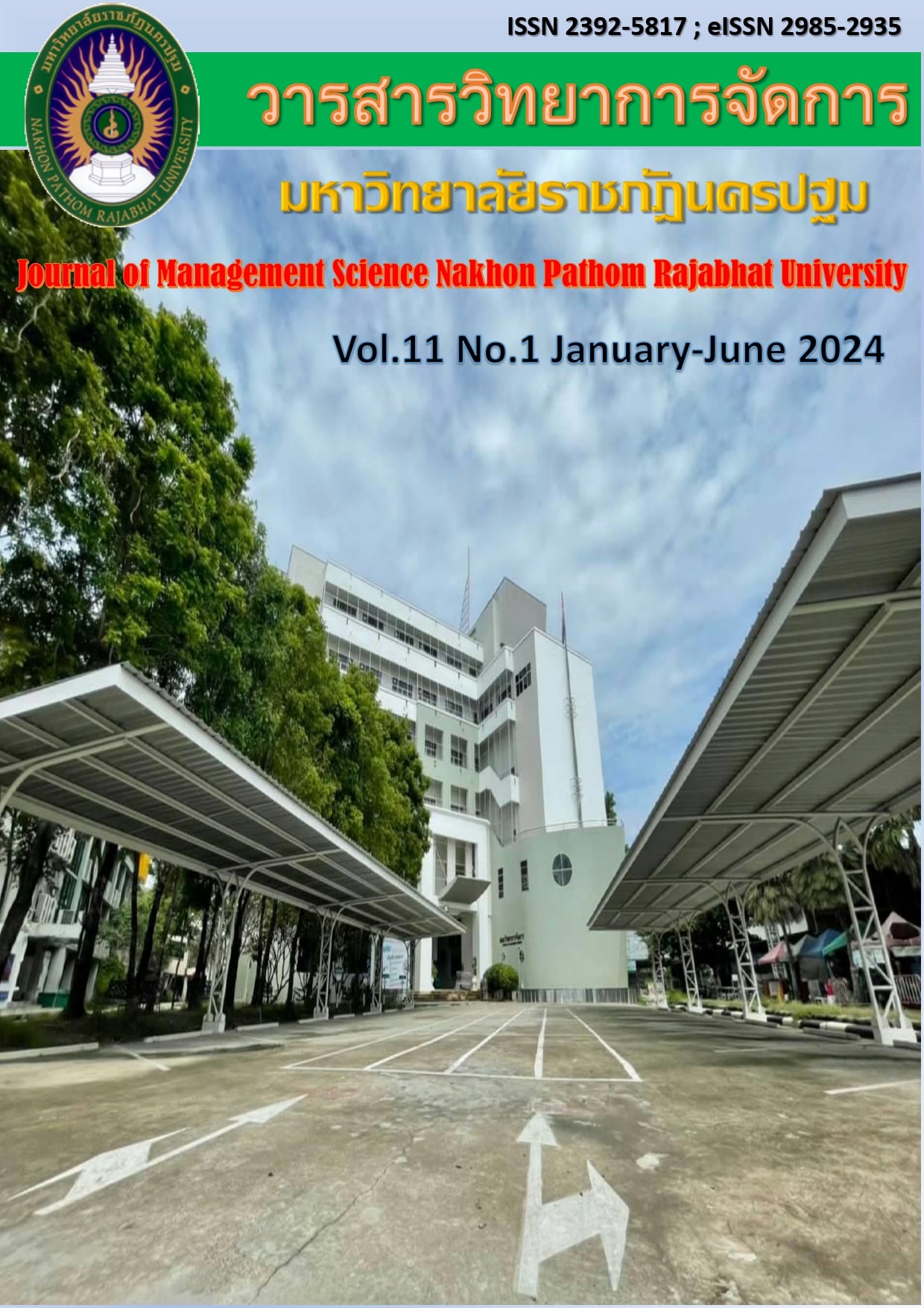Development of an innovative tourism model for a sustainable community in Trang Province
Main Article Content
Abstract
The research format was qualitative. There were 3 groups of key informants: a group of 20 people involved in the public sector, a group of 10 people involved in the private sector, and a group of 5 experts, totaling 35 people. In-depth interviews were used as the research tool. The collected data were analyzed for content.
The research results found that (1) the environment and identity of Trang Province were characterized by abundant and beautiful resources, but improvements were needed in the scenery of certain areas and in learning resources to enhance their appeal to tourists. Additionally, the main infrastructure and transportation routes were still insufficient and did not meet international standards. Utilizing local wisdom to create unique business value and promoting communities with cultural highlights were recommended. (2) The management process and sustainable tourism development in Trang Province showed that, as a tourism hub in the southern region, Trang Province featured diverse tourist attractions, particularly notable natural attractions both on land and at sea. However, there was a need for further development towards sustainable tourism. Tourism activities should have efficiently provided information through various online media systems to reach a wide audience. Products and services should have highlighted the uniqueness of Trang Province while demonstrating social and environmental responsibility. Developing an innovative tourism community required active participation from local community members. (3) Development guidelines included establishing a community network and fostering connections with other community networks and various forms of public relations, both online and offline. Additionally, original tourist attractions should have been developed, and new ones should have been created to enhance tourism offerings.
Article history: Received 25 April 2024
Revised 3 June 2024
Accepted 4 June 2024
SIMILARITY INDEX = 10.18 %
Article Details

This work is licensed under a Creative Commons Attribution-NonCommercial-NoDerivatives 4.0 International License.
The views and opinions of the article appearing in this journal are those of the author. It is not considered a view and responsibility of the editorial staff.
References
กรมการพัฒนาชุมชน. (2561). คู่มือบริหารโครงการชุมชนท่องเที่ยว OTOP นวัตวิถี. กรุงเทพมหานคร: ม.ป.ท.
กรมส่งเสริมวัฒนธรรม. (2562). วัฒนธรรมคุณค่าสู่มูลค่า. ค้นเมื่อ ธันวาคม 3, 2566, จาก http://www.culture.go.th/culture_th/ewt_news.php?nid=3972&filename=index
กฤษณะ ดาราเรือง. (2564). แนวทางการพัฒนาชุมชนท่องเที่ยว OTOP นวัตวิถี บ้านหนองกระดูกเนื้อ ตำบล หนองนมวัว อำเภอลาดยาว จังหวัดนครสวรรค์. วารสารวิชาการวิทยาลัยบริหารศาสตร์, 4(4), 105- 122.
กวี วรกวิน. (2562). ภูมิศาสตร์การท่องเที่ยวประเทศไทย. กรุงเทพฯ: สำนักพิมพ์บริษัทพัฒนา คุณภาพวิชาการ (พว.) จำกัด.
กันตภณ แก้วสง่า และนิศาชล จำนงศรี. (2558). การจัดการความรู้การท่องเที่ยวเชิงสร้างสรรค์ในแหล่งท่องเที่ยวทางวัฒนธรรม อำเภอพิมาย จังหวัดนครราชสีมา. วารสารเทคโนโลยีสุรนารี, 9(2), 79-103.
การท่องเที่ยวแห่งประเทศไทย. (2566). แผนพัฒนาการท่องเที่ยวแห่งชาติฉบับที่ 3 (พ.ศ. 2566 – 2570). ค้นเมื่อ ธันวาคม 3, 2566, จาก https://planning.dusit.ac.th/main/wp-content/uploads /2023/06/แผนพัฒนาการท่องเที่ยวแห่งชาติ-ฉบับที่-3-พ.pdf
เกียรติพงษ์ อุดมธนะธีระ. (2565). plan13 แผนพัฒนาเศรษฐกิจและสังคมแห่งชาติ ฉบับที่ 13 สรุป. ค้นเมื่อ ธันวาคม 3, 2566, จาก https://www.iok2u.com/article/strategic-plan/pian13-sum
ดุสิตพร ฮกทา. (2560). แนวทางการพัฒนาศักยภาพการท่องเที่ยว จังหวัดตรัง. วิทยาลัยการโรงแรมและการท่องเที่ยว. มหาวิทยาลัยเทคโนโลยีราชมงคลศรีวิชัย.
ธง คำเกิด และคณะ. (2564). การจัดการท่องเที่ยวโดยชุมชนบนฐานรากวิถีชีวิตชุมชนอย่างยั่งยืน ของตำบลต้นตาล อำเภอสองพี่น้อง จังหวัดสุพรรณบุรี. คณะศิลปศาสตร์ มหาวิทยาลัยเทคโนโลยีราชมงคลสุวรรณภูมิ ศูนย์สุพรรณบุรี.
นิตยา งามยิ่งยง และ ละเอียด ศิลาน้อย. (2560). แนวทางการพัฒนาการท่องเที่ยวอย่างยั่งยืนชุมชนบริเวณริมฝั่ง คลองดำเนินสะดวก ในจังหวัดสมุทรสาครและจังหวัดราชบุรี. วารสารวิทยาลัย ดุสิตธานี, 11(1), 149- 166.
ประกาย วุฒิพิพัฒนพงศ์. (2565). ศักยภาพการท่องเที่ยวโดยชุมชนตามโครงการชุมชนท่องเที่ยว OTOP นวัตวิถี กรณีศึกษา: หมู่บ้านท่องเที่ยวทางธรรมชาติและวัฒนธรรมพื้นบ้านอีสาน (บ้านซะซอม) อำเภอโขงเจียม จังหวัดอุบลราชธานี. คณะรัฐศาสตร์และนิติศาสตร์ มหาวิทยาลัยบูรพา, 41-63.
ปาริชาติ คุณปลื้ม. (2562). ศึกษาชุมชนท่องเที่ยว OTOP นวัตวิถี. วารสารวิชาการศรีปทุม ชลบุรี.16(1), 14-22.
พิรดาภร ใจหาญ. (2566). แนวทางการบริหารจัดการการท่องเที่ยวโอทอปนวัตวิถี ที่เสริมสร้างความเข้มแข็งของชุมชน ในจังหวัดนครพนม. วารสารสังคมศาสตร์ปัญญาพัฒน์, 5(2), 41-56.
วัลลภ วรรณโอสถ. (2564). รูปแบบการจัดการการท่องเที่ยวโดยชุมชน OTOP นวัตวิถีเพื่อการพัฒนาชุมชนอย่างยั่งยืน. วิทยานิพนธ์ปรัชญาดุษฎีบัณฑิต สาขาวิชาการจัดการ แบบ 2.1 ปรัชญาดุษฎีบัณฑิต บัณฑิตวิทยาลัย มหาวิทยาลัยศิลปากร.
ศศิชา หมดมลทิล. (2562). ท่องเที่ยวโดยชุมชนวิถีสู่ความยั่งยืน. ค้นเมื่อ ธันวาคม 3, 2566, จาก https://www.gsbresearch.or.th/wp-content/uploads/2019/10/GR_report_travel detail.pdf
ศูนย์ประสานงานเครือข่ายการท่องเที่ยวโดยชุมชน. (ม.ป.ป.). การท่องเที่ยวโดยชุมชน. ค้นเมื่อ ธันวาคม 3, 2566, จาก https://thaicommunitybasedtourismnetwork.wordpress.com/cbt/
หลักการของการท่องเที่ยวอย่างยั่งยืน ในสารานุกรมไทยสำหรับเยาวชนเล่ม 27 ,2542 [Online]. Available : https://www.saranukromthai.or.th/sub/book/book.php?book=27&chap= 3&page=t27-3-infodetail02.htm [2566, ธันวาคม 3].
David B. Weaver. (2003). The encyclopedia of ecotourism. CABI Publishing Series.
Etsuko, Okazaki. (2008). A Community-Based Tourism Model: Its Conception and Use. Journal of Sustainable Tourism, 16(5), 511–529.
Fennell, J. (1999). Contemporary Urban Planning. New Jersey : Prentice-Hall.
Harwood, S. (2010). Planning for Community Based Tourism in a remote location. Sustainability, 2(7), 1909–1923
Lo Y-C and Janta P. (2020). Resident’s Perspective on Developing Community-Based Tourism – A Qualitative Study of Muen Ngoen Kong Community, Chiang Mai, Thailand. Front. Psychol. 11:1493. https://doi: 10.3389/fpsyg.2020.01493.

